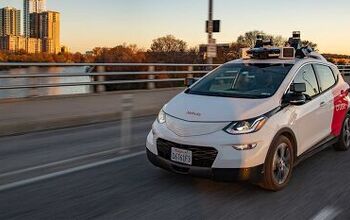Yet Another Transmission Shifter Problem at Fiat Chrysler; 1.48 Million Rams Recalled

For a while, it seemed Fiat Chrysler Automobiles’ fancy (and confusing) console-mounted monostable shifters and newer rotary-dial shifters were out to give every FCA executive a headache. Unfortunately for them, there’s new safety issue causing vehicle rollaways, and this time it’s from a seemingly tried-and-true bit of automotive gear.
The traditional column shifter.
FCA is now recalling 1.48 million Ram pickups spanning nine model years to prevent further injuries and accidents.
Past recalls and investigations involved operators of monostable shifters incorrectly thinking they had shifted into park (when the vehicle was actually still in drive or reverse), or vehicles with rotary gearshifts rolling away after the driver selected park. This recall concerns the failure of the shift interlock in certain vehicles, which allows the shift lever to be accidentally moved out of the park position.
From the company’s media release:
An FCA US review of field data led to the discovery that Brake Transmission Shift Interlock (BTSI) may not function properly if subject to specific high-temperature conditions for prolonged periods. The conditions are consistent with those that occur when there is protracted brake-pedal application while a vehicle is idling in park.
If BTSI becomes disabled, a vehicle’s shifter may be moved out of park without brake-pedal application, or the presence of a key in the ignition. In such circumstances, a vehicle may exhibit inadvertent movement – if its parking brake has not been set, as recommended in FCA US owners’ manuals.
The automaker claims it is aware of seven “potentially related” injuries and a “small number” of accidents that might stem from the wonky shifters.
FCA says the recall will restore BTSI function in the affected vehicles. There’s a number of Ram models included in the campaign, with most falling under the Heavy Duty banner. The recall includes 2010-2017 Ram 2500 and 3500 pickups, 2011-2017 Ram 3500, 4500 and 5500 chassis cabs, 2016-2017 Ram 3500 chassis cabs (with a Gross Vehicle Weight Rating of less than 10,000 pounds), and some 2009-2017 Ram 1500 pickups.
Trucks from the 2017 model year built after December 31st, 2016, are not included in the recall. If you’re worried about the vehicle sitting in your driveway, there’s a number (866-220-6747) to call. Meanwhile, give your left foot a workout and start using that parking brake.
[Image: Fiat Chrysler Automobiles]

More by Steph Willems
Latest Car Reviews
Read moreLatest Product Reviews
Read moreRecent Comments
- MaintenanceCosts Nobody here seems to acknowledge that there are multiple use cases for cars.Some people spend all their time driving all over the country and need every mile and minute of time savings. ICE cars are better for them right now.Some people only drive locally and fly when they travel. For them, there's probably a range number that works, and they don't really need more. For the uses for which we use our EV, that would be around 150 miles. The other thing about a low range requirement is it can make 120V charging viable. If you don't drive more than an average of about 40 miles/day, you can probably get enough electrons through a wall outlet. We spent over two years charging our Bolt only through 120V, while our house was getting rebuilt, and never had an issue.Those are extremes. There are all sorts of use cases in between, which probably represent the majority of drivers. For some users, what's needed is more range. But I think for most users, what's needed is better charging. Retrofit apartment garages like Tim's with 240V outlets at every spot. Install more L3 chargers in supermarket parking lots and alongside gas stations. Make chargers that work like Tesla Superchargers as ubiquitous as gas stations, and EV charging will not be an issue for most users.
- MaintenanceCosts I don't have an opinion on whether any one plant unionizing is the right answer, but the employees sure need to have the right to organize. Unions or the credible threat of unionization are the only thing, history has proven, that can keep employers honest. Without it, we've seen over and over, the employers have complete power over the workers and feel free to exploit the workers however they see fit. (And don't tell me "oh, the workers can just leave" - in an oligopolistic industry, working conditions quickly converge, and there's not another employer right around the corner.)
- Kjhkjlhkjhkljh kljhjkhjklhkjh [h3]Wake me up when it is a 1989 635Csi with a M88/3[/h3]
- BrandX "I can charge using the 240V outlets, sure, but it’s slow."No it's not. That's what all home chargers use - 240V.
- Jalop1991 does the odometer represent itself in an analog fashion? Will the numbers roll slowly and stop wherever, or do they just blink to the next number like any old boring modern car?































Comments
Join the conversation
The BTSI solenoid on the Promaster becomes too hot to touch after only a minute or so. Much longer than that and it will melt the shifter housing. I think in practice your foot will get tired of holding the brake before that happens. No AT park pawl is designed to hold any vehicle parked, especially on a hill. They are anti-theft devices, plain and simple. FMVSS brake standards test the parking brake only, not anything in the transmission. They are overbuilt to survive this abuse at least until the warranty period expires, that is all. When we had to have a vehicle recertified for FMVSS 105 after some modifications, we used a prototype that didn't even have a park pawl and the proving ground didn't care. FCA's BTSI solenoid isn't nearly as problematic as their key lock solenoid and ignition switch. Oy!
Why do manufacturers try to reinvent the stuff that already works?